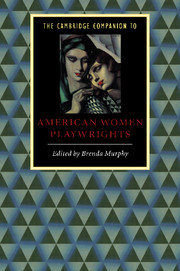12 - Contemporary playwrights/traditional forms
from Part 3 - New feminists
Published online by Cambridge University Press: 28 May 2006
Summary
A story is always a question of desire. But whose desire is it that speaks, and whom does that desire address?
Teresa de Lauretis, Alice Doesn't, 112.The appearance of significant women dramatists … is a real reflection of a change in women’s attitudes towards themselves. It is a sudden understanding that they can be, and indeed are, the central characters in their own lives.
Marsha Norman, in Betsko and Koenig, Interviews, 338.In the 1980s, a striking phenomenon occurred on the American stage. In an eight-year span, three women dramatists, Beth Henley, Marsha Norman, and Wendy Wasserstein, were awarded the Pulitzer Prize, approaching the total of five Pulitzers awarded to women for the previous sixty years. This same period saw the production of new plays by Tina Howe, Maria Irene Fornes, Emily Mann, Ntozake Shange, and Wendy Kesselman, among others, as well as the establishment of avant-garde, alternative women’s theatre companies, both in New York and around the country. In a 1992 New Republic article entitled “What Do Women Playwrights Want?” Robert Brustein refers to the “spate of plays by, for, and about women that have multiplied in the last decade,” saying that “in terms of numbers, if not in broadness of theme, American women playwrights now represent a significant movement that is surely unprecedented in history” (28). I would like to examine how three women playwrights, Henley, Norman, and Howe, drawing on realistic modes, use these traditional forms to dramatize feminist perspectives.
- Type
- Chapter
- Information
- The Cambridge Companion to American Women Playwrights , pp. 195 - 212Publisher: Cambridge University PressPrint publication year: 1999
- 1
- Cited by

